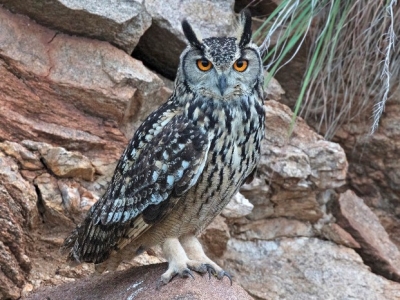
The Indian eagle owl, or Bubo bengalensis, also called the Bengal eagle-owl or rock eagle is a large-sized owl that belongs to the family Strigidae. It is a handsome looking bird with brown and gray plumage speckled with dark patches and pale underparts. It has beautiful, orange eyes and prominent dark brown ear tufts. It is very similar-looking to the Eurasian-eagle owl, except that its facial disk is ringed by dark feather which is less visible in the Eurasian eagle owl. It is distributed across India, Pakistan, Nepal and Myanmar, where it prefers woodland, rugged landscapes and forests.
The Indian eagle owl has exceptional hearing and sight and makes a silent and deadly hunter. It prefers to hunt from a perch from which it dives to catch any prey that it spots. Its primary source of food is rats and mice, but it will also feed on reptiles, frogs, crabs and partridges when possible. It has a loud, booming call that is heard mainly during dusk and dawn. During the day it may be seen roosting under a bush, on a rocky hillock or in a leafy tree.
The female generally lays 2 to 4 creamy, white eggs in bare soil or in a natural recess such as a rock ledge or under a bush. Such nests are called ‘scrapes’. The incubation period lasts around 33 days and the young are cared for by the parents even after the fledgling stage until they are independent – which may take about 6 months.
Sadly, this beautiful creature has been victimized due to superstitious beliefs, which project it as a bad omen. This causes many people to hunt and kill this gentle wood dweller and sometimes perform gruesome cruelties upon it.
It comes under the ‘Least Concern’ category in the IUCN Red List and has survived due to its broad range and its protection under law in India.
Picture Credit : Google




